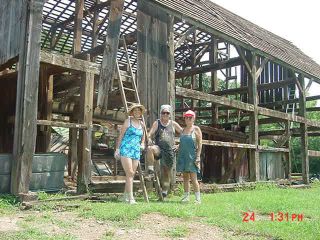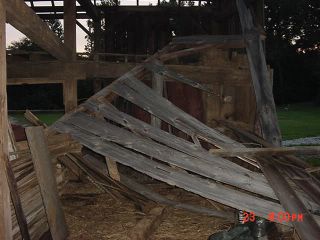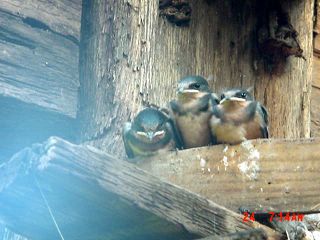Wednesday, November 15, 2006
Postponement
Of fifty-eight main timbers and twelve top plates, only four, two 24-ft posts and two 23-ft beams, and the bulk of the top plates (8X8s, 20-24 feet long) remain to be completed. We will finish them this year, but the days are getting very short, the weather will soon be very cold, and about ten of them still need to be cut down in the future pond area, dragged out to the saw mill and "carved out" of the trees.
The foundation still must be dug and poured, and weather is an issue there, too. Also, if we put the timbers up yet this year we would need to install the rafters and roofing in the worst weather. The height of the barn combined with cold and maybe wet or snowy weather could make that a miserable (and perhaps dangerous) task this time of year. So the timbers will be protected under large billboard tarps through the winter.
We will take our time, finish the timbers, and lay out the foundation this year, and dig and pour it and erect the barn when it starts to warm up again. We can always use more time to work on plans for the interior, too.
On another topic, you should see the corduroy road that Sandy built almost single-handedly where the "road" had gotten very muddy at its clearing end. All sorts of wood scrap pieces from the milling operation were used, including some very bumpy left over log sections. It's raining again today, but I'll see her effort again tomorrow afternoon and report on how effective it is.
The tent I'd been using is put away for the winter and the pallet platform it was on is covered with a large tarp. Underneath has likely already been appropriated by some of our smaller wildlife friends. We'll let them have its use until springtime at least.
Sunday, October 29, 2006
Should the barn have a silo?
Today, on the way home from the site, we visited a fellow who has converted his barn into his home and had a new silo added next to it. We learned of him from the fellow who built the silo. Here's a picture. Ours would be taller.
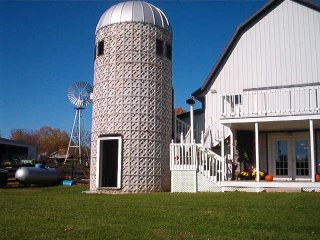
Since a stairway in the barn will use most of an entire bay, we have discussed using a silo instead to provide access to the barn's second floor. The silo would also provide a high observation point on the property from which we could see most or all of the homes depending on where it were placed.
We would build a staircase inside and have a door on both the ground and second floor levels with a railed walkway to the barn. Occasional windows along the stairs would allow natural light to enter. A platform would be built about 4 feet below the top of the silo and a smooth cap of some sort would be added to cover the tops of the silo panels. A removable cover would keep out any bad weather.
We will dicuss the possibility further. If we decide to build it maybe we can pour its foundation along with the barn foundation.
Monday, August 21, 2006
Sorting posts, building a platform, surveying
I have been scraping and painting the last section of the eaves in the house in preparation for selling it. We held the last yard sale last weekend and got rid of a lot of stuff that we won't need in the future downsized house. We have rented a 10X20 storage room about 7 miles from Raccoon Creek and have moved about 2/3's of the home's contents to it or my daughter-in-law's garage. We still have bedroom, living room and dining room furniture in the house, but the dining room suite is for sale.
I have begun turning the front yard back into the standard, cookie cutter yard like every other one on the block by digging up all of the perennials in preparation for planting grass. Just the space between the sidewalk and the street has yielded about 60 large pots of plants. Many were sold at the yard sale, and more will be sold on the weekends we are at home, but most will go with us to Raccoon Creek. The rest of the front yard I estimate will yield about 200 more pots of perennials. I don't know how I'm going to deal with the hundred or so bulbs whose locations are only marked by their appearance in the spring.
Last week we finally put our most important agreements on how we will develop Raccoon Creek Community on one page. Most of the decisions had already been written in minutes of various meetings, but even we couldn't have found them all easily if we had to, so putting them on one page was a useful exercise. You can read them here.
Sunday we did the final survey for the property transfer. Approximately two acres have been added to place all of the planned east side pond within the community's boundaries. We were concerned that a future transfer of adjacent property to a land trust might cause some of the pond to become off limits to Raccoon Creek Community members due to "liability issues."
Today we began to sort through the barn parts that have been stored on the site since last fall. The plan is to lay out each bent (five posts, two post extensions and about 10 beams each) and decide which members have to be replaced. As each bent is inventoried it will be restacked as a set. When all six bents are catalogued, the process of making replacement parts will begin. We will then have to get really busy to get the 30 foundation piers built and the foundation walls between them before the new timber frame members are made aqnd the barn erection can go ahead.
If you are interested in the timber framing process, these next few weeks would be a great time to visit the site. We hope to use some trees from the pond site as replacement material for the old posts and beams we cannot use. These will be pulled from the woods using draft horses. Dates for that work will be set soon.
Finally today, using 15 discarded wooden pallets and eight @4X8 sheets of salvaged particle board, a platform was constructed to make tenting on the site for the next few months much more attractive. We will be able to leave a tent up without worrying about water seeping in when it rains, and without the usual lumps under our bedding. There is plenty of room for other tents from time to time.
If you'd like to come by to visit the site while we're there, send a note to the address in the column to the left of this entry.
Thursday, July 20, 2006
Engineer needed
Owen County officials have said they will approve the plan for just the frame and roof so we can concentrate on preserving the barn. Later, after it is up and safe, we will design and get their sign-off for the exterior and interior details. But before we can get the construction started we need to have an engineer to help design the foundation and sign off on it.
If you know of someone who would be good for this job, please let us know.
Vacation's over: back to work
Since returning we have met with Red Tail Timber Frames owner and have agree to have them manage the reconstruction of our barn. They will begin in early August.
Missing posts and beams - parts that had rotted in the barn before we dismanteled it - will be replaced with timbers harvested from areas which will become ponds on the Raccoon Creek site. Red Tail will pull them from the woods using their draft horses, and mill them with their portable saw mill.
We have taken out a building permit for the barn, talked again with our REMC and gotten a quote from a well driller. Soon we will erect a tent or two and some screen tents so we can work at the site for a few days in a row without traveling back and forth so often.
If you've been wanting to visit the site, these next few weekends would be a great time. After that we should be very busy working on the barn.
Monday, December 05, 2005
A weekend of ups and downs
The finished product of the survey will be a topographic map of the site with 1-foot contours. Currently, the best topo we have is the USGS 10-foot contours. That only gives a rough idea of the site, not enough detail to plan any building locations, roads or ponds and water catchment locations.
We did not survey the entire site, partly because there is a "tail" section that we aren't likely to "develop" to the extent that a 1-foot topo is needed, and partly because we wanted to take all the "shots" within two days.
The process was very instructive. Modern surveying equipment makes the job way different from when I played surveyor as a kid with a scope and a friend with a marked stick. The primary piece of equipment, the transit or theodolite, is a complex box about the size of a few bricks. It calculates direction, angle of elevation above or below, and, using infrared beams, the distance to the "stick" to within thousandths of a foot.
The "stick" is an extendable pole with a point on the top and bottom with a very precise circular mirror at a fixed height. Markings on the inside pole tell one how far from the ground the point is. These mirrors are remarkable. They are actually made of six mirrors that each are precisely 60 degrees of the circle. These are precisely set in a concave six-sided pyramid so that no matter from which direction one looks into the assembly, one sees the same picture of oneself. Move up or down, left or right, and one still sees the same part of one's face. This is very important, of course, because the mirror needs to precisely bounce the infrared beams back to the transit, and the stick holders cannot possibly get a precise 90 degree angle on the transit from sometimes hundreds of feet away.
So the process is to set up the transit on a point and take "shots" of the sticks at various points within sight of the transit. Each of these sightings are stored in a computer as data points. When all the points that can be shot from the transit are taken, the transit is moved to another point. A stick is placed where the transit was, and a shot is taken from the new point back to the previous point to verify their relationship to one another.
This process continues across the entire site, setting transit points by "backshooting" to earlier ones, and taking shots in every direction from each transit point. The more shots, the more precise the end product will be.
The trick is to take enough shots to get all the contour changes so the computer, where all the data points are processed, can place the data points on the map and interpolate between them to describe the contour lines. To get the best detail one must take shots on the center line, the "center of flow", of each stream, and the "toe" and "top of bank" on both sides. These five shots are taken at points along each stream where the route or the elevation changes. Shots are taken where there are changes in the slope, and also at scattered points across the entire area.
Again, the more shots, the better the product, but, obviously, there's a point beyond which the cost would outweigh the value of the extra precision. With two days to take the data points, we had to decide where to spend more time to get more shots and more detail, and where more detail wouldn't be all that useful, and, consequently, we could take fewer shots and still get what we need.
Within a week we should see the result of our work.
Tuesday, October 04, 2005
Unloading and stacking wood
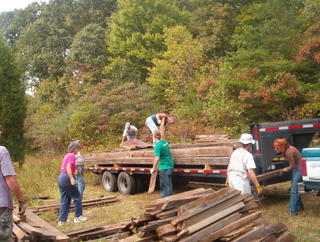
Here are a few pictures from the work day on Sunday. It wasn't a particularly exciting effort, but we had to get the barn parts under cover and protected for the winter.
Five members, two volunteers, three who came with the truck and trailer, and one very small person were on site to help unload the trailer. The truck bed lifts, so it unloaded itself, though we had to stack all the beams that were on it and some from an earlier load more neatly.

A few critters showed up to watch us work. This praying mantis is the first I've seen on the site. It has already turned a bit brown and would have been invisible if it had stayed on the meadow grasses. It was actually larger than it appears here - about six inches long.
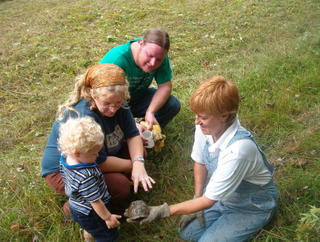 This box turtle is typical of many found at Raccoon Creek. It is probably the first that our youngest helper has ever seen. I'm amazed they can make headway through the tall meadow plants.
This box turtle is typical of many found at Raccoon Creek. It is probably the first that our youngest helper has ever seen. I'm amazed they can make headway through the tall meadow plants.We still could benefit by consolidating some of our wood stacks and moving one or two a bit further from the center of the clearing. Maybe when it cools off a bit. It's not supposed to be in the high 80's in October.
Friday, September 30, 2005
It's all down

It's been a long summer. After nearly 20 working visits to the barn site, and a few trips to Raccoon Creek to prepare for and unload wood from the trucks, it is all down to the ground.
On Tuesday we arrived at the site with a crew of two experienced in taking down barns and an enormous crane that could be raised to about 90 feet and its operator.
The crane was able to lift small and large sections from any part of the barn, all from the same spot. (Remember, the barn was 60 by 54 feet.) It had a "basket" that could lift two men to anywhere on the barn and provided ample space to work without getting in each others' way.
It was interesting to see a few of the crane's
 safety features. For example, if the hook was raised too high, before jamming in the top pulley, it lifted a weight, which took tension off a switch, which shut off the winch that lifted the hook. Also, if the weight on the hook and the angle of the crane together threatened to tilt the truck, the boom would stop until more cable was played out and it was lifted higher to reduce the angular force, or until some weight was removed.
safety features. For example, if the hook was raised too high, before jamming in the top pulley, it lifted a weight, which took tension off a switch, which shut off the winch that lifted the hook. Also, if the weight on the hook and the angle of the crane together threatened to tilt the truck, the boom would stop until more cable was played out and it was lifted higher to reduce the angular force, or until some weight was removed.The process was to lift us to a spot, attach a strong strap to one or more barn parts, remove the pins and nails, loosen the part as best we could, then set the basket down to let us out, attach the strap to the crane's hook, and lift the piece or section off the barn and place it on the ground where we could disassemble it.
Sometimes the lift was a single piece, like one of the stringers attaching two posts together longways at the top of the barn.
 Other lifts were two to eight posts and beams that were tightly connected and more easily came down as one unit. There might even be a few knee braces included in the unit.
Other lifts were two to eight posts and beams that were tightly connected and more easily came down as one unit. There might even be a few knee braces included in the unit.
One mistake we made was not being careful to lay the units down the "right way," meaning with the correct side up to allow us to knock pins out from the top as the sections lay on the ground. We set many of the units down the "wrong way" and lost lots of time later taking them apart.
For each connection, we first tried to pound out the pin and "wiggle" the smaller part's tenon out of the mortise in the larger part. This wiggling wasn't as simple as it sounds. Many of the connections were still very tight after 140 years. We use a long 4X4 to pry and push the beam left and right as someone else inserted a wrecking bar, rock, wedge or board into the crack between the parts. At each change of direction, the crack opened up more and the a larger wedge could be inserted until the beam finally disconnected. It took two people to lift a typical beam, so this wiggling process took some time. Sometimes we were able to pound the pieces apart, but not often.
If knocking out the pin proved impossible, because it was too tight, had bent or broken inside the connection over the years, or the connection was wrong side up, we used a drill to core the pin holding the tenon in the mortise before using the "wiggle method" described above to separate the parts. Often the drill left what can best be described as a wooden straw inside the hole because the drill was just a tiny bit smaller than the pin or because the course of the drill missed part of the pin on the inside. In these cases we had to drill again (and sometimes again) to remove all the pin.
The last resort was to saw off the tenon. We tried to reserve this approach for beams with tenons that had already rotted away and would not be reusable. These beams will be used by attaching them to their posts with strong angular steel plates.
Some of the dismantling on the ground was done on Tuesday and Wednesday by two of us - enough for a truck load of beams. On Friday three of us worked nine hours and another for the last three to take apart every useful post, beam and knee brace. As it was getting too dark to work, the last pieces came apart and we loaded the generator to return it to the rental site.
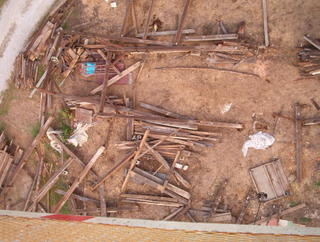 A very tired crew drove back north in the dark. When we left the site looked like a giant game of pick up sticks.
A very tired crew drove back north in the dark. When we left the site looked like a giant game of pick up sticks.Our selective logging friend was to return on Saturday to load all the useful parts onto his large truck and a long trailer for transport to Raccoon Creek. On Sunday we will meet the trucks and stack all the wood better to protect it for the winter.
I'll post lots of barn pictures on the web site next week.
Monday, September 12, 2005
Best laid plans
Some of our community went to the barn site on Saturday and moved another large load of wood to Raccoon Creek. The truck owner tagged a few more trees that need to be taken down to allow the larger trailer to get onto the site, so we will spend a day or so between now and the 28th doing a bit more widening.
This weekend we will be manning a table at Bloomington's Simply Living Fair. If you've got an interest in simplifying your life, this fair is a great place to learn how. Visit our table if you can attend, and plan to have dinner with us on Saturday and/or Sunday evening to talk about Raccoon Creek and our upcoming permaculture course. (Discount deadline is the 21st of September.)
The following weekend may be the best time to restack the barn wood that has already been taken to the site. It should be a great time of year to spend a day at Raccoon Creek, or even to camp overnight. Let us know if you'd like to help for a few hours that weekend.
Wednesday, September 07, 2005
Last post before there are no more posts
Last weekend we removed all the nails in all remaining wood that has been taken off the building. All the board were stacked in preparation for transporting them to Raccoon Creek, and a large load of rafters and purlins was moved and slid off the truck in the larger clearing.
Help is needed this weekend to load the truck another time and to stack and cover the wood in the clearing. Loading should take less than a few hours on Saturday, faster with more help. Stacking and covering the load in the field on Sunday will take less than an hour. Please let us know if you can help on either end. I am away until Sunday evening, but you can contact me by email with your phone number and I will pass on your offer to the person coordinating the move.
The next work will begin on Tuesday the 13th when help arrives in the form of a few experienced people and some heavy equipment to allow us to take the beams and posts down. If all goes well the timbers will all be on a large trailer in two days, or maybe three.
Once the trailer pulls away, we'll likely need to return to the barn site for a day to do some final cleanup and remove some trash.
It will be nice to be able to concentrate our energy on the Raccoon Creek site after that. I bet you might be tired of reading about the barn, too.
Sunday, August 28, 2005
The roof is gone!
Using the lift, one person rode to the top of the inside of the barn while another climbed the purlins on the lower pitch of the roof's west side. (The upper pitch purlins were removed weeks ago.) Each pried off one end of each rafter and the "lower" person slide his end aside until it fell off the header and dropped to the ground. This was repeated until all the rafters in a bay were dislodged and dropped.
Then the lift was lowered, moved to the next bay, and raised to the top again. The process was repeated, dropping about 6 rafters for each move of the lift, until the whole west side top pitch was removed.
Then the purlins on the east side top were removed so the rafters could be taken down next. On this side the lift was even more helpful. As each bay of rafters was dislodged at the bottom by the person standing on the lower east side purlins, the lift was used to lift them off the bottom while they were still attached to the top header. This made it a simple task to push the wrecking bar under each rafter, unlike the rafters on the other three pitches, most of which were tightly nailed down and took considerable effort to pry them off. Then, as each rafter was pried off at the top, the lift rider hung onto it while he hung up his wrecking bar, and pushed the rafter down over the hip of the roof and gave it a push. Each rafter slid down the lower pitch and landed on the east side of the barn.
Next the lower east side purlins came off, the bottom four or five rows being removed from the list platform, now on the east outside of the building. Using the lift saved probably 3/4ths of the time for these last rows which otherwise would have had to be removed while standing on a ladder, and climbing down to move the ladder every 6 rafters or so.
On this pitch of rafters, from the lift platform, we pried the lower end up and swung it left or right until it cleared the header it had been nailed to. Then it was dropped just as the top pitch of the west side had been dropped, only not so far.
Finally the lower west side purlins and rafters were removed in the same way as the lower east side.
The bad news: many of the rafters broke when they fell. Many were already cracked, especially at the notches. In some cases the length below the bottom pitch notches - the roof overhang - was already disconnected from the rest of the rafter. Only the purlins, attached to adjacent rafters, had been holding these rafter fragments. Obviously, if the roof is rebuilt like it was, the rafters that are broken or damaged cannot be used.
The good news: All but a handful of the damaged rafters will make great joists for the lofts that had no flooring to begin with.
Next: take out nails, stack and load and transport to Raccoon Creek, take down, load and transport posts, beams and knee braces to Raccoon Creek.
Sunday, August 21, 2005
Barn history
At the time of the 1859 map of Floyd County, the property at what is now 201 Hausfeldt Lane (Hossfeld) was owned by Peter Smeaton and his wife. As of 7-06-05, I have not been able to trace the ownership further back.
On September 24, 1860, the property (66 acres) was sold to Barbara and John G. Beck.
On May 21, 1866, the property was sold to Francis and Louis Fraaz.
On February 27, 1869, Francis H. Fraaz transferred half of the 66 acres to Jacob Vetterlin.
On December 6, 1870, Louis Fraaz and Anastatia, (his wife) and Jacob Vetterlin sold all 66 acres to William Geltmacher.
On November 28, 1872, William Geltmacher and Catherine (his wife) sold the property to Ignatius Ohlmann.
On December 18, 1878, Ignatius Ohlmann (marital status not shown) sold the property to Ernst Hossfeld, my great-grandfather, and the one for whom the road was named.
The farm came down through 4 generations of my family, with parts of the property being sold off at times until there was just under 5 acres remaining, this part containing the barn. This remaining property was sold to the present owner, Janet Burkhart, in September of 2004.
From what I was always told, 3/4 of the barn was existing when my ancestors bought the property in 1875. At that time, the "dog trot" or drive though was down the center of the barn and the barn had a gable roof. According to family lore, my great grandparents enlarged the barn by adding a series of bays to the west side, making the "dog trot" off center, and by splicing 2 sets of upright posts and raising the roof, they made the roof into the gambrel shape as is exists today.
In some publications, I've read, the barn was dated as going back to the 1860's and early 1870's. As there were a number of owners during that time period, it could have been erected by any of a number of persons.
My father ran the farm until the 1960s. After that the farm was sharecropped and the barn no longer used. A lot of the ground was sold in 1980 and the farm ceased operations; thus, the barn was not used except for storage since that time.
If anyone should stumble across any additional information about the barn, please contact us.
Saturday, August 20, 2005
Moving day
Truck rental was an expense I had hoped to keep to a minimum. The going rate for mileage charges for trucks here is $.79/mile! By the time we take it back tomorrow we will have put almost exactly 400 miles on it, and I was so sure we could find a truck to borrow.
We stacked the "good stuff" this morning before heading back to the barn site for another load. Tomorrow we plan to just dump everything off and try to get the truck back before the established return time. I hope we have enough time to cover all the piles with tin roofing. There's plenty of roofing, but I'm not sure there will be plenty of time.
We'll have to get some folks down to the site over the next few weeks to get the lumber sorted and stacked neatly. Otherwise, when we need it in the spring, we'll spend too much time searching for what we need.
Left to do at the barn site:
Remove remaining purlins and rafters.
Take down all posts and beams.
Truck posts and beams to Raccoon Creek
Monday, July 25, 2005
97, 98, 99...
Work has been done on eight days out of the last ten, so we'll soon run out of things that can be done on the ground. None of the roof work can proceed until at least two people who can be on the roof are on site at the same time. Not surprisingly, not everyone wants to get up there.
On Wednesday, an entire loft collapsed while we were removing wood from it, and Mother Nature pitched in by dropping about a third of the north end of the barn in a large storm on Thursday night when we weren't at the site. The same storm lifted a very heavy oak joist that was attached to a tarp for rain and sun protection now that the roof is off, and threw it about 15 feet further into the barn.
The other picture below shows the wood that was brought down "for free."
This coming weekend we'll have another go at it, probably from Friday through Sunday.
Aside from cleaning up little things, there are three major aspects left: finishing the roof - three pitches of purlins and all the rafters; taking down the headers, posts and beams; and moving the disassembled barn to Raccoon Creek.
The roof...
Our hope is to lower each rafter with two ropes managed from the ground as the people on the roof disconnect rafters from each other and tie them onto the ropes.
Before any of this can begin, we need to reinforce, and, in one case, supplement, three of the main posts along the north wall. We had known for some time that some of the posts would need to have their bottom foot to three feet replaced with sound wood when we reconstruct the barn, but the extend of damage to these three main posts was unknown until all the stalls, mangers, and loft floors and joists were removed. I think we can nail some of very solid (and very heavy) oak joists at multiple points to the bottoms of the bad posts to keep them stable while the rafters and remaining purlins are removed above them. This added support can remain on the posts until each is lowered to the ground and stacked for transport.
Major posts and beams...
We have discussed various methods of lowering the posts and beams. Hiring a large crane would be the quickest, but also the most expensive. Since we are trying to save the mortise and tenon connections between posts and beams and knee braces, a crane would be idle more than it was running to allow us time to pound (or drill) out the pins holding the connections. If we sacrific the pinned joints we could cut the connections with a saw and speed the rwmoval.
We discussed renting a cherry picker or a man-lift to get us up to each connection while we knock out the pins and tie the beams for lowering, and then using the same device to help lower them. The problem with this approach is that the beams may be too heavy to be lowered by the device which would also be supporting the weight of the operator.
We are considering starting from a corner and disconnecting each post from the beams connecting it, then lowering it, disconnecting the other end of each beam, and lowering each of them. The process would continue from post to post, always working on an outside corner post. We'll be discussing this approach with our advisor to see if it is feasible. It would take longer, but the cost would be very low, just lots of rope and pullies.
Moving the disassembled barn to Raccoon Creek...
We are trying to develop an inexpensive plan for loading, moving and storing the barn until next spring. That might employ a flat-bed trailer, or a covered trailer. The covered trailer, if kept over the winter would serve the added purpose of storing the lumber, and maybe other things, on the site. A flat-bed, on the other hand would be easier to load but the lumber would need to be covered in some other way.
If you know of anyone who might be able to help with this transportation and storage problem, please let us know at rcc@netdirect.net. If we don't solve it inexpensively, it could become the most costly aspect of the entire project.
Birds
Most of the swallows have now left with only two nests lost with either eggs or babies in them. About a month ago a nest was lost because the joist on which it was built just fell over after the boards on top had been removed. The joist had either never been nailed to the beams or the nails had rusted away. In either case, the nest fell with three or four eggs in it. There was nothing we could do.
Last week, though, we were luckier. Even though I had recovered each active nest we found with boards after removing the floor over them, once the roof was removed, last weekend's rain weakened the last swallows' nest and it fell to the ground. This was probably the first water to touch that spot in 130-plus years.
Fortunately I found the nest soon after it dropped. We had plenty of scrap wood, and enough reuseable nails, so I built a quick and dirty nest box on a post high up under a beam and covered it with another wider board.
I put the remains of the nest on the ledge, mostly mud and feathers, and then put in the four babies, each with its first tiny feathers. It might have helped that I was wearing work gloves, so I never actually touched the babies. Happily, the parents found it and continued to feed them! In fact, about 10 swallows swarmed around the nest for the rest of the day, and occasionally over the next few days I was there. Swallows are very protective and constantly swooping and chirping at us as we work near their nests.
See "The three amigos" picture below.
Yesterday, as I was trying to get a closer picture of them in their makeshift roost, of the remaining three who had not yet flown, two of the babies took to the air for the first time. The first of the four had apparently already flown successfully. That left one, and when we left Sunday after 7 PM, he (or she, how would I know?) was still there, occasionally flapping his wings and trying to get the parents' attention. They had essentially abandoned him, but must have had a change of heart since they were again feeding him when we left. He should be gone before the next trip to the barn.
That leaves just one robins' nest to go. Both of those parents are feeding their four babies, at least that's how many eggs there were as seen from the roof last week. If all goes well, they'll be gone before we remove the purlins over their nest.
Monday, July 18, 2005
Permaculture instruction comes to Raccoon Creek
For those who haven't heard the term "permaculture" or are unsure of its meaning, here are a few definitions as written by others:
o The design of sustainable human habitats based on the observation of natural systems and uses ecological principles to increase diversity and productivity of local human ecosystems. Permaculture designs incorporate food, energy, and shelter for people and animals while linking the needs and outputs of each element of the system. The result is a dynamic yet stable system that sustains itself. Permaculture designs can be developed for any climate and on any scale, from balconies to entire villages.
o The conscious design and maintenance of agriculturally productive ecosystems which have the diversity, stability, and resilience of natural ecosystems. It is the harmonious integration of landscape and people providing their food, energy, shelter, and other material and non-material needs in a sustainable way.
o According to Bill Mollison, the creator of the Permaculture Design Concept, "Permaculture is the conscious design and maintenance of agriculturally productive ecosystems which have the diversity, stability and resilience of natural ecosystems. It is the harmonious integration of landscape and people providing their food, energy, shelter and material and non-material needs in a sustainable way. Permaculture design is a system of assembling conceptual, material and strategic components in a pattern which functions to benefit life in all it's forms."
The course cost will include lodging, meals and a permaculture manual. More information on the course, including a course outline, the cost, instructor bios and other details will be posted here soon.
Please set these dates aside. If you would like to talk about the course before the next announcement, send an email to rcc@netdirect.net.
Sunday, July 17, 2005
Let it rain
Friday went pretty well. Two of us took off more than half of the west side roofing sheets while the others continued to move boards, pull nails, remove some of the lower nails on the roof from a ladder and pick up lots of wood pieces.
Saturday was another story. It started out pretty well, but then it rained, and rained, and rained. We had been to the site a half-dozen times without even a sprinkle, and the first rain waited until the roof was off to drench us. We were up and down the ladder again and again, removing roof panels, hiding from the rain, removing panels, hiding. Some trips to the roof netted only a panel or two before the next squall came through. (Did I mention it rained a lot?)
A tarp was nailed up to make at least one small space on the barn floor that wasn't being rained on, and folks continued dragging boards under the tarp to remove nails. Metal roofing sheets and newly nail-free boards were dragged to the storage area between the rain showers. Almost all of the straw that was piled in a few of the bays was spread around the barn where the rain and our foot traffic had made a muddy mess.
The afternoon forecast was for more of the same, so those who had not planned to stay overnight cleaned up as best they could and got an early start toward home. There were enough pauses in the rain to allow the last 10 roof panels to be taken down before dark with a bit of time left to remove the final ground floor siding from two of the corners.
Sunday, weather wise, was a repeat of Saturday, with just a bit more time before the heavy rains arrived. The sheetmetal was brought into the barn to be used to cover boards we wanted to save. All the purlins were removed from the top pitch of the west side and they were either tossed on the waste pile or brought in for nail removal depending on their quality. Instead of prying up each nail with a crowbar, it proved to be easy to pop them off with a five foot length of two-by-four.
Our "expert" arrived early Sunday morning to critique our work so far and to offer suggestions for the next steps to be taken. If possible we will take down the rafters by lowering them one at a time. If we can do this it will save hundreds of dollars of crane rental and operator time expense. We'll need a generator to saw through the nails that hold rafters together at the peak of the roof and where the two pitches come together on each side. They are held tightly by four large nails in each coupling, and they are nailed tightly to the headers. It is not possible to pry them apart, especially while standing on top of a roof, clipped onto a climbing rope. With a "saws-all" we should be able to both separate each pair from each other, and separate them from the headers on which they rest.
So... it looks like at least one more full weekend before we're ready for a crane. It was suggested today that we might be able to take the beams and posts down using a "cherry picker" like those used to repare power lines and replace street lights. This would save even more money - it should be cheaper than a crane and not require an operator. We'll check into this possibility this week.
And for those of you following the barn project who would like me to get back to discussing Raccoon Creek, stand by. We hope to have a major announcement as early as tomorrow.
